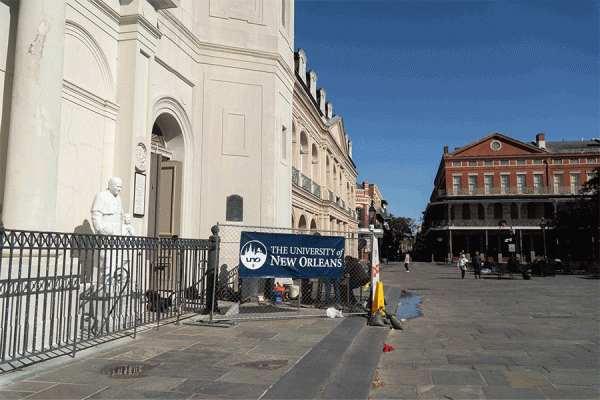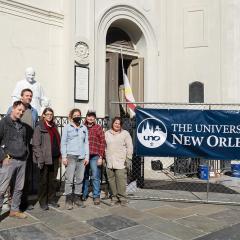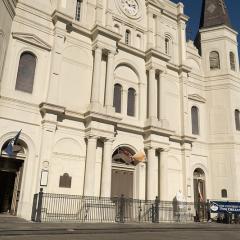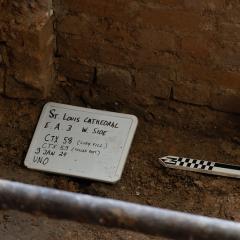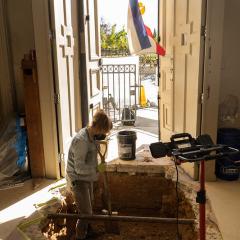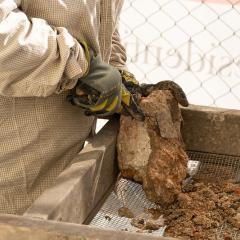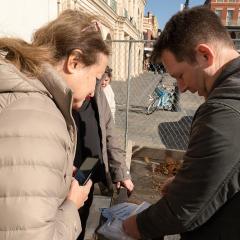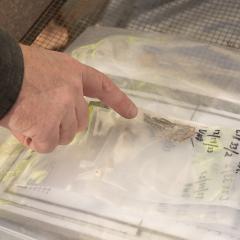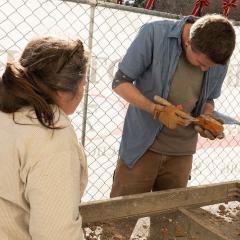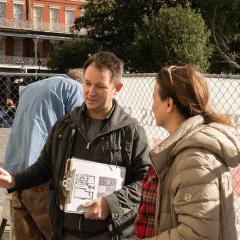While a brass band played to the delight of tourists who clapped and swayed to the spirited beats that filled the air in Jackson Square one breezy January afternoon, a short distance away, University of New Orleans students stood sifting—literally—through the soils of time at St. Louis Cathedral.
The famed cathedral, located in the French Quarter, sits on one of the oldest church sites in North America. The first church constructed on the site dates to the 18th century. University of New Orleans anthropology professor Ryan Gray, who specializes in urban historical archaeology in the city of New Orleans, and his team were examining a portion of the 300-year-old foundation.
According to a welcome plaque placed in the vestibule of the main sanctuary, the current cathedral was completed in 1851 and is built over the foundations of a colonial 1727 church. It is the oldest active cathedral in the United States, according to church officials.
“We have other projects always happening, but it’s not often that you get projects where you’re digging underneath St. Louis Cathedral,” said Gray, who is also associate director of the Midlo Center for New Orleans Studies. “It really is a one-of-a-kind project! I may spend the rest of my career doing archaeology in the city and this may be the only time we get to do something like this.
“It’s rare to have well-preserved French colonial era sites, even in the French Quarter because there’s been so much building that has happened on top of them,” Gray said.
As part of a planned restoration project, contractors excavated two pits to examine the condition of the cathedral’s foundation, which was laid in 1849. The Archdiocese of New Orleans requested UNO’s archaeological team after contractors came across evidence of much older foundations, Gray said.
“We were able to determine that these earlier foundations were almost definitely those of the St. Louis Church constructed in 1724-1727, the first permanent structure built on the site,” Gray said. “We found artifacts in the layers consistent with this period, including both French and Native American pottery, glass, clay smoking pipe fragments, fish bone, a part of a religious medallion, a bead, and nails.”
The excavated site measures about six feet deep and is located in an interior side foyer.
An unusual amount of tiny straight pins was found among the layers, Gray said. He believes these brass straight pins were used to fashion curtains in the earliest church.
“When the church was first finished in 1727, there were no window panes available,” Gray said. “They stretched fabric across the windows, and we think that the reason we have so many straight pins is that what was being used to hold the fabric; to pin it in place and hold it tight.”
In addition, when the team cleaned up the excavations and examined the stratigraphy, they found that the various layers contained a record of the entire 18th century history of the site, Gray said.
“Including renovations to that first church, evidence of the 1788 fire, the reconstruction of the cathedral in 1794, and its expansion into the present version in 1849,” Gray said. “We hope that, by working closely with the contractors on the next excavation, planned to span the front right doorway of the cathedral, we can help refine the chronology of the site in the 18th century and use the layers to think about the social history of this area at the center of the city.”
Gray’s historical expertise is frequently called upon by public and private entities when something of archaeological significance is unearthed. He most recently oversaw a team excavating another of the city’s landmark, Madame John’s Legacy, the second-oldest building in the French Quarter, built in 1789.
As the cathedral’s bell toned the noon hour to signal the start of mass, Gray and his crew cleared out of the foyer. There is no excavating during the service, he said.
Gray headed to a screen station that was set up outside to examine some of the finds that have been bagged and labeled. He’s pleased that UNO is able to prevent the potential loss of archaeological artifacts through site documentation and preservation.
“UNO is the only institution in the city that has archeologists and can put together a project like this on short notice for anyone,” said Gray. “There’s really no one else doing this type of work in the entire city. For a project like this, that’s not getting any federal money, there’s no requirement for them to do the archaeology. It’s something that’s really a central part of our mission to be able to help and do these sorts of things.”


